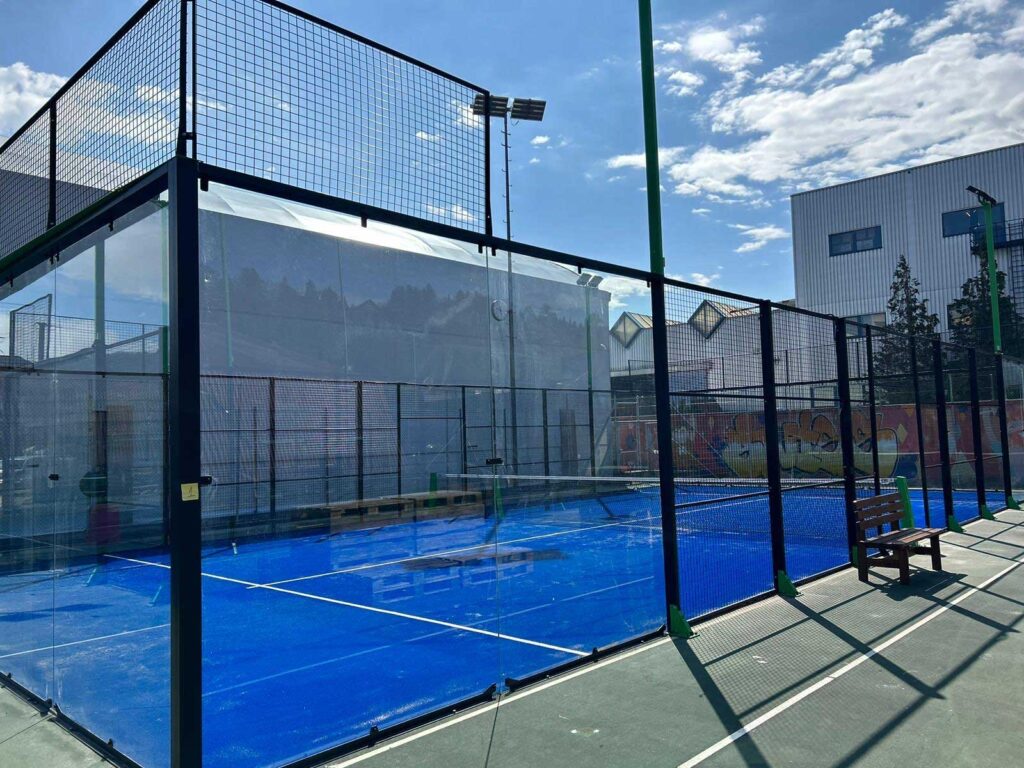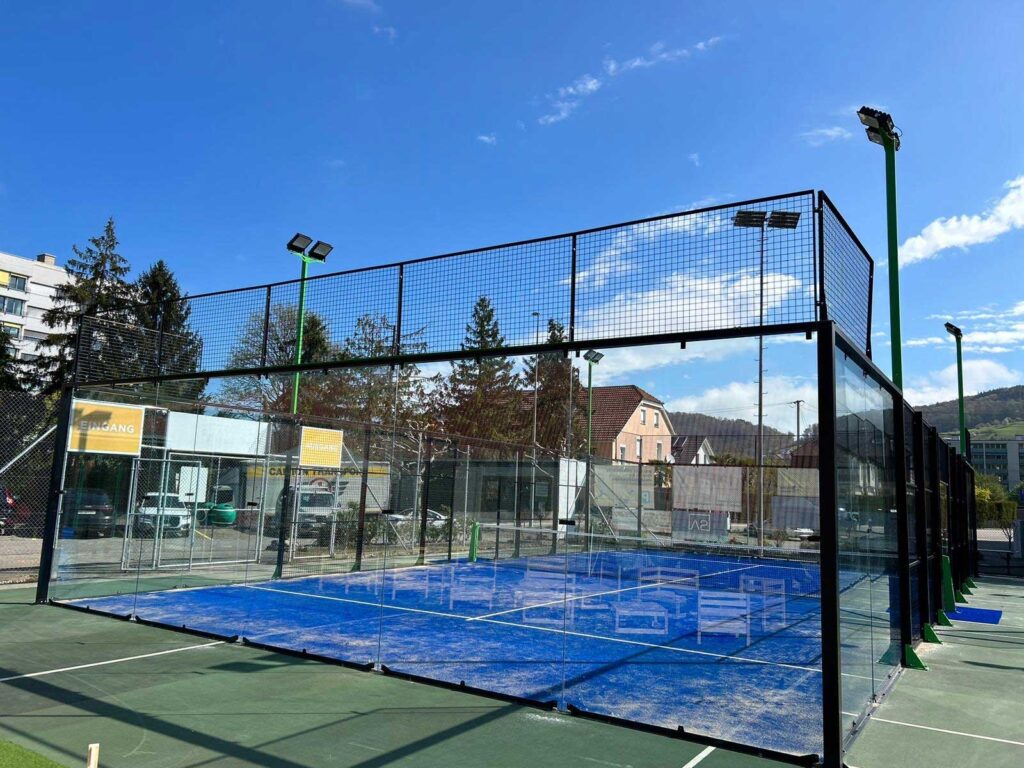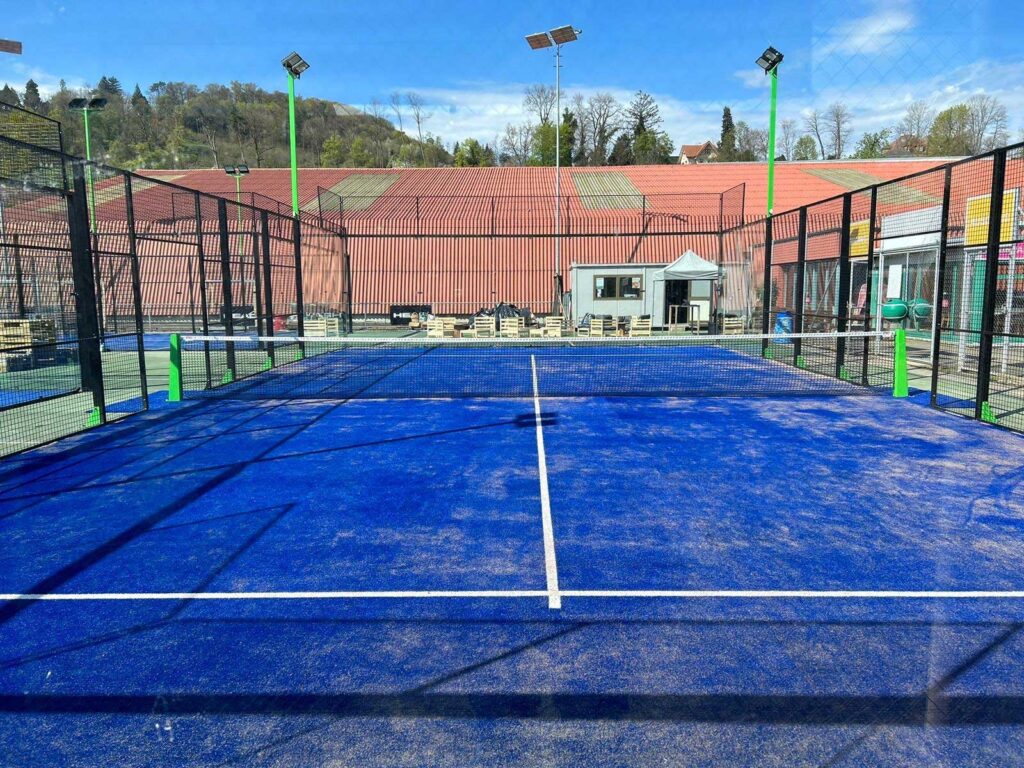Welcome to Padel Frenkendorf
Your Center for Outdoor and Semi-Indoor-courts








Our tournaments and events








What is padel?
Padel is a racket sport that combines the best of tennis and squash.
Padel owes its great popularity in Spanish-speaking countries (over 10 million players!) to its enormous fun factor and the fact that it is easy to get into.
Padel court, game mode & rules
The padel court is a rectangle measuring 10×20 metres and is divided into 2 halves by a net, as in tennis. The court is surrounded by glass or concrete walls and grids, which can be included in the game in a similar way to squash. The T-shaped lines on the artificial turf surface are only relevant when serving. Roofed courts require a ceiling height of 6 metres, and floodlights are often provided for night-time play.
Padel is always played by 4 people, i.e. in doubles over the net in the centre. Points are scored and counted in the same way as in tennis (two touches of the ball in the opponent’s court) – however, the serve in padel takes place below the hips. Details on the padel rules and the game with the walls can be found here.
Padel rackets and balls
Padel rackets are significantly shorter than tennis or squash rackets and measure a maximum of 45.5 cm long, 26 cm wide and 38 mm thick. The hitting surface is also not strung but made entirely of plastic or carbon fibre, with holes in the surface to reduce air resistance. The grip is wrapped with standard grip tape.
The easy introduction to the game is mainly due to these racket properties, as they make a successful shot less technically demanding. The lack of stringing also takes some of the speed out of the game compared to other racket sports.
Padel balls are basically tennis balls, but have slightly less pressure (which also helps to slow down the game).
Who can play padel?
Women, men, old, young, fat, thin: everyone can play padel and even together (!). That is the outstanding feature of the sport, padel brings everyone together in sporting fun. In Spain (where there are 4 million of them), the number of male and female players is almost equal. Children can play from the age of 3-4.
LOSS OF POINTS?
If the ball hits your side twice or a player is hit, you lose a point. The ball must always hit the ground first and may not be played directly against the walls of the opponent’s court.
HOW ARE POINTS CALCULATED?
As in tennis, set and game count. The counting method is 15/30/40/game. To win a set, you must win at least six games and be in the lead with at least two games won. If the score is 6:6, there is a tie-break, with the winner taking the set 7:6. Usually the best of 3 or 5 sets is scored for this.
Padel is a racket sport that combines the best of tennis and squash.
Padel owes its great popularity in Spanish-speaking countries (over 10 million players!) to its enormous fun factor and the fact that it is easy to get into.
Padel court, game mode & rules
The padel court is a rectangle measuring 10×20 metres and is divided into 2 halves by a net, as in tennis. The court is surrounded by glass or concrete walls and grids, which can be included in the game in a similar way to squash. The T-shaped lines on the artificial turf surface are only relevant when serving. Roofed courts require a ceiling height of 6 metres, and floodlights are often provided for night-time play.
Padel is always played by 4 people, i.e. in doubles over the net in the centre. Points are scored and counted in the same way as in tennis (two touches of the ball in the opponent’s court) – however, the serve in padel takes place below the hips. Details on the padel rules and the game with the walls can be found here.
Padel rackets and balls
Padel rackets are significantly shorter than tennis or squash rackets and measure a maximum of 45.5 cm long, 26 cm wide and 38 mm thick. The hitting surface is also not strung but made entirely of plastic or carbon fibre, with holes in the surface to reduce air resistance. The grip is wrapped with standard grip tape.
The easy introduction to the game is mainly due to these racket properties, as they make a successful shot less technically demanding. The lack of stringing also takes some of the speed out of the game compared to other racket sports.
Padel balls are basically tennis balls, but have slightly less pressure (which also helps to slow down the game).
Who can play padel?
Women, men, old, young, fat, thin: everyone can play padel and even together (!). That is the outstanding feature of the sport, padel brings everyone together in sporting fun. In Spain (where there are 4 million of them), the number of male and female players is almost equal. Children can play from the age of 3-4.
LOSS OF POINTS?
If the ball hits your side twice or a player is hit, you lose a point. The ball must always hit the ground first and may not be played directly against the walls of the opponent’s court.
HOW ARE POINTS CALCULATED?
As in tennis, set and game count. The counting method is 15/30/40/game. To win a set, you must win at least six games and be in the lead with at least two games won. If the score is 6:6, there is a tie-break, with the winner taking the set 7:6. Usually the best of 3 or 5 sets is scored for this.
With the kind support of
Stronger together: We are delighted to introduce our valued sponsors who support us on our journey. Through these dedicated partnerships, our padel center becomes not only a place for sports but also a hub for collaboration and success. Get to know the companies that share our vision and contribute to our achievements:






